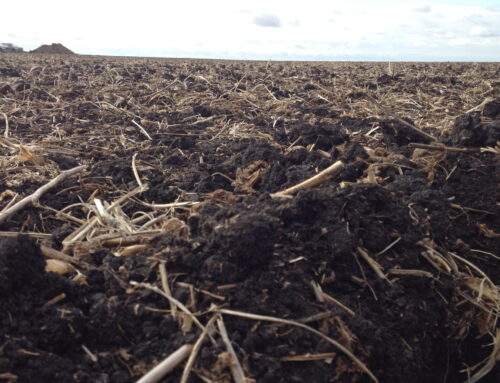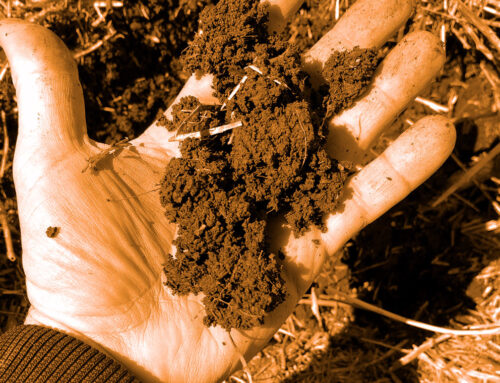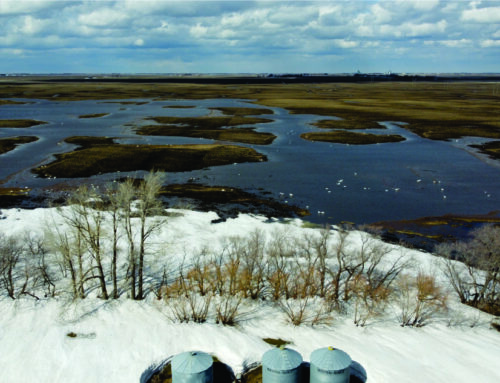The modern approach to agriculture is focused on the production of monoculture crops (one plant species grown at once). Production often includes practices such as tilling in fall or spring to prep the seedbed, followed by the addition of synthetic fertilizers for optimum yield. The latest and greatest seed varieties are then planted which could have a seed treatment, plus a variety of pesticides used to keep the field clean from invading pests. These practices, however, can distract producers from maintaining and depending on healthy soil to provide the nutrients our crops need to achieve our yield targets. It is time to start exploring the relationship between all the microbial communities that exist in the soil organic matter and the plants we grow.
Soil is alive. It is this organic component of the soil that sets it apart from a heap of sand, silt and clay (www.ndsu.edu/soilhealth) and researchers estimate that roughly 90% of the functions we expect a soil to perform are the result of biological activity. There are a plethora of organisms living in the organic matter of soil, such as bacteria, actinobacteria, fungi, protozoa, nematodes and earthworms to name a few. There are roughly 2,000 pounds of organisms, or the equivalent weight of two mature cows, per acre of healthy soil. These organisms are an integral part of the soil food web, where microbes convert nutrients from one form to another, allowing them to become available to plants and other organisms. These processes are critical to producing crops efficiently.
90% of the functions we expect a soil to perform are the result of biological activity
John stika, a soil owner’s manual
The plant-microbe relationship
Microbes and plants have a symbiotic relationship. Plants harvest sunlight and water to produce carbohydrates (sugar) which they secrete into the soil via their roots. These sugars are then traded with microbes in exchange for nutrients the microbes have liberated from the soil. Approximately 90% of nutrients absorbed by plant roots have been processed by a microbe into a plant available form that can then be used by the intended plant. When synthetic fertilizers are applied to the soil, the plant-microbe relationship is jeopardized as the plant will access the readily available nutrients from the fertilizer rather than depending on the soil organisms to provide nutrients from the organic matter. This works in the early growth stages of the crop, however when the fertilizer has been used or immobilized, the plants can become deficient as they must expend extra energy to develop a relationship with the microbes in the soil food web for them to provide the nitrogen the plant needs for growth and yield. The utilization of energy at the mid-point of the growing season could cost the producer yield, as the plants are communicating with the microbes to receive the nutrients they require to finish growing. If this relationship had been established and maintained at the beginning of the season, both plants and microbial communities would have the food supply they need. We need to rethink how we feed our plants. Feeding crops using the soil food web is how Mother Nature intended it and is a more resilient system rather than trying to feed the plant directly.
Another shift in our thinking is about a microbe’s home or habitat. Microbes are the work horses of the soil factory and live in the tiny pore spaces between soil aggregates – the lumps and clods of soil particles held together by the excrements of plants and organisms. Microbes not only convert the nutrients in the soil into forms the plants can use, but they also build and maintain aggregates which in turn become their home. Stable soil aggregates are the backbone of a functioning soil. These structures allow roots to penetrate the soil easily, water to infiltrate after a rain, air exchange between the soil and atmosphere can occur, and the soil can support the above ground traffic that moves across it. Devin Coleman-Derr, a scientist at University of California, Berkeley, explains that some mircobes are destined to inhabit certain plants and they want the roots they inhabit, as well as the rhizophere, which is the area around the roots, to be their dream homes. If an organism partners with a plant to help it grow, it is essentially building a better home for itself. Virtually all aspects of the plant’s life are connected to the microbes present, therefore we need to re-evaluate our management decisions to maintain the structural stability of our soils, promote the diversity of microbial colonies present and leave their homes intact.
Some microbes are destined to inhabit certain plants and they want the roots they inhabit to be their dream home. When microbes partner with plants to help them grow, they’re essentially building a better home for themselves.
Devin coleman-derr, scientist at university of california, berkeley
The importance of aggregate stability
Aggregate stability is critical for infiltration, root growth, microbial habitat and resistance to water and wind erosion. Unstable aggregates disintegrate during rainstorms. Dispersed soil particles fill surface pores and a hard physical crust can develop when the soil dries. Infiltration is reduced, which can result in increased runoff and water erosion, and reduced water available in the soil for plant growth. A physical crust can also restrict seedling emergence (www.soilquality.org).
Practices that lead to poor aggregate stability include:
- Tillage methods and soil disturbance activities that breakdown plant organic matter, prevent
accumulation of soil organic matter, and disrupt existing aggregates - Cropping, grazing, or other production systems that leave soil bare and expose it to the physical impact of raindrops or wind-blown soil particles
- Removing sources of organic matter and surface roughness by burning, harvesting, or otherwise removing crop residues
- Using pesticides harmful to beneficial soil microorganisms
Plants have been maintaining a symbiotic relationship with soil organisms for longer than there have been farmers working the land. The plant-microbe relationship ensures each other’s survival. The microbes build soil aggregates and cycle nutrients for plants to use. In return, plants excrete sugars to feed the microbes. Our farm management decisions need to provide the conditions that mimic soil building processes again. To be successful, we need to focus our practices on feeding and watering our crops through the soil food web instead of trying to feed and water them directly. Once we make that paradigm shift, we can view soil as the way to get the job done versus as it being in the way.









